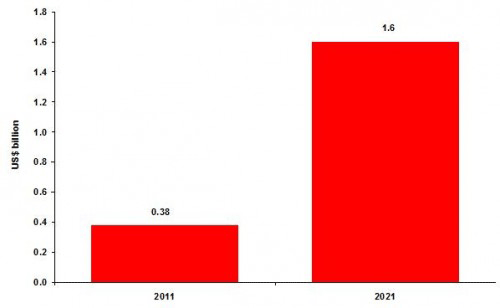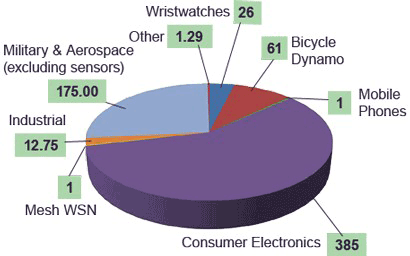Next week the IDTechEx Energy Harvesting & Storage USA event will open in Boston to more than 350 attendees from 16 countries. Below are some of the highlights you should expect from the show.
Powering wireless sensors
For many years wireless sensors for home automation lay in the wilderness until governments around the world began to mandate their use in smart meters. More than 50 million smart meters are now installed worldwide, and it is the beginning of meters talking to thermostats, room occupancy sensors and home networks. Indeed, initiatives are under way to install sensors ubiquitously in cities – one such project in Europe – “LivingPlanIT” – is installing almost 3 million sensors in the first wave of a “trial” in a new “test-city” in Portugal. Many wireless sensors will also need energy harvesters to enable twenty year lifetimes, overcoming lifetime limitations of conventional batteries. Those solutions are now being deployed.
IDTechEx find that the market for wireless sensor networks will reach $2 billion in 2021. These figures refer to WSN defined as wireless mesh networks, i.e. self-healing and self-organizing.

Source: Wireless Sensor Networks 2011-2021 www.IDTechEx.com/wsn
This event covers the new wave of technologies and their progress to providing building control and automation, ultimately feeding it into the smart grid enabling far greater energy efficiency and many other benefits. We look at what you should expect to come, debate the path to get there and cover the unmet opportunities. The event features presentations from companies providing case studies of their application and what is coming next, examples being Perpetuum, Microgen, MicroStrain, EnOcean and others. The success of these systems depend on the demand for wireless sensors and the event covers this with presentations from companies providing or using wireless sensors such as Cubic Global Tracking Systems and Living PlanIT.
Beyond wireless sensors
However, for those making energy harvesters, associated energy storage and low power systems, wireless sensors are but one opportunity. Many are also striving for energy harvesting in consumer electronics and vehicles. The Marketing Store, One Laptop Per Child, Ford, Volvo and others cover the opportunity from an end user perspective. Indeed, this all creates a market opportunity of $4.4 Billion for energy harvesters ten years from now. In 2011, IDTechEx research finds that the amount of money spent on energy harvesters will be $0.7Bn, with several hundred developers involved throughout the value chain.
The majority of the value this year is in consumer electronic applications, where energy harvesters have been used for some time. In 2011, 1.6 million energy harvesters will be used in wireless sensors, resulting in $13.75 million being spent on those harvesters. The full breakdown is shown below.

The Energy Harvesting Market in 2011 $0.7Bn: • Wristwatches, 32 million $26 million • Bicycle Dynamo, 6.3 million $61 million • Mobile Phones, 0.1 million $1 million • Consumer Electronics, 550 million $385 million • Wireless Mesh Networks, 0.1 million $1 million • Industrial (non mesh), 1.5 million $12.75 million • Military & Aerospace, 0.05 million $175 million Source: Energy Harvesting & Storage 2011-2021 by IDTechEx www.IDTechEx.com/energy
Wireless power
Another aspect of the topic is wireless power transmission (WPT). There has been a huge effort to standardize WPT systems, with many of the world's consumer electronics companies involved. Over the next decade, the most vibrant wireless power transmission markets will involve the contactless charging of portable and mobile equipment, in particular consumer electronics, electric vehicles and wireless sensors. These aspects go together because the technology is similar, some proposed standards overlap and some suppliers seek to serve both markets.
Later, this will lead to contactless power for a high proportion of static consumer, industrial and military electronics. For now, it primarily concerns wireless charging of lithium-ion batteries in portable consumer electronics and in land, water and airborne electric vehicles, particularly cars, both hybrid and pure electric. These travel considerable distances and ready availability of standard, convenient ie contactless, charging capability is key to their widespread adoption. To the user of consumer electronics, this is particularly driven by the ever greater functionality and longer hours of use of mobile phones calling for frequent charging, given that the batteries are not improving fast enough.
Companies such as Leggett & Platt Automotive Group, WiTricity and Fulton Innovation will be presenting on this topic. For more information read the IDTechEx report on the topic at www.IDTechx.com/wpt.
Thermoelectrics
While most energy harvesters are solar and electromagnetic based today, there has been a surge in development of thermoelectric energy harvesters. Indeed chemical giant BASF will present on their thermoelectric activities, and Marlow, Nextreme and Amerigon will cover the points that need to be considered when looking to use a thermoelectric energy harvester and will cover case studies of their use.
Stretchable and flexible energy harvesters
Stretchable electronics is offering new product opportunities. MC10 will discuss how their electronics can stretch and flex enabling wearable electronics, indeed they have announced a partnership with Reebok. Princeton university are developing piezoelectric ribbons printed onto rubber, enabling flexible energy conversion that could be implanted or integrated with textiles. Others are combining more than one energy harvester onto the same device, such as the University of Bolton in the UK who will present on their integration of a piezoelectric polymer and photovoltaic system on a film or fibre.
Energy Harvest & Storage USA brings the whole topic together for you – end-user needs, technology progress and hands-on product interaction. For more details and to register see www.IDTechEx.com/boston
Advertisement
Learn more about IDTechEx





